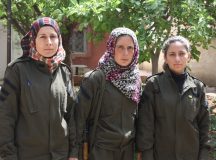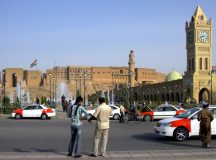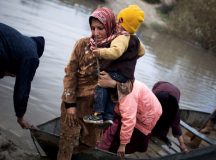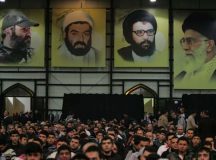Jonathan Spyer, a Middle East analyst, author and journalist specialising in the areas of Israel, Lebanon, and Syria spoke to a Fathom Forum in London about the ISIS-Kurdish war. He argued the war should be seen against a larger canvass – a single sectarian war currently taking place in Iraq, Syria and Lebanon, fought out mainly between two forms of political Islam. He also reflected on the implications for western policy-makers.
A person who I regard as the best political analyst on Syria, a man called Mahmoud Mousa, who works with the foreign media in Syria and comes politically from the circle of the moderate rebels and civilian Syrian opposition, said to me when I visited Syria in May that there are only three serious forces in Syria today: ISIS, the regime and the Kurds – this tells you a lot about the state of the other forces touted as potential partners for the West. Of the three serious forces, two of them – ISIS and the Kurds – have been engaged in a war for territory in the course of just over a year and a half.
I would argue that this is a war between successor entities. The Syrian state has effectively ceased to exist as a coherent governing entity; what still calls itself the Syrian state (Bashar Assad and his various allies) should better be seen today as only one of a number of successor entities fighting over the corpse of what was once Syria.
This is better understood as a war of ground and resources, rather than as a war over forms of governance for some notional future united Syria – which will probably never emerge. Once one understands the ISIS-Kurdish war in that way, it begins to make obvious sense – obvious geographic sense first of all. What you have in the case of the Kurdish successor entity and the ISIS (or Sunni Islamist) successor entity is a natural collision in geographic terms. The Kurdish entity is organised east to west, in three separate enclaves along the Syrian-Turkish border: the Jazira enclave, stretching from the Iraqi-Syrian border across the northern part, a gap under rebel control, then the Kobani enclave in the middle, and further to the west the town of Afrin.
The ISIS enclave is organised from south east to north west, stretching deeply into Iraq, taking Raqqa and Deir ez-Zur provinces as its heartland and stretching up towards Aleppo province. These two entities, by their very nature, collide with one another and must – out of necessity – fight over borders, in order to get access to resources.
Why is the Kobani enclave so important and formed the main centre of clashes? It is a Kurdish controlled enclave which sticks like a knife into the heart of the ISIS entity. It stops ISIS from being able to move forces from its capital in Raqqa city to Aleppo province where it would like to, which means they have to drive the long way round. ISIS is therefore determined – for geopolitical rather than ideological or ethnic reasons – to wipe out this Kurdish enclave and to have a much more contiguous area of territory from the Syrian-Turkish and across to the Syrian-Iraqi border in the east.
The broader nature of the conflict in Iraq and Syria
Seeing Syria, and increasingly Iraq, as wars between central governments taking on insurgencies challenging the nature of their rule, is increasingly a redundant way to see this conflict. I would suggest that a better frame for seeing both conflicts is as a single sectarian war taking place across borders in Iraq, Syria, and increasingly Lebanon. One can see alliances (coherent or less coherent) stretching across these borders, constituting a single war on various fronts.
We can see a clearly crystallised and united Shia/minority alliance, a much more confused picture on the Sunni Arab side and a Kurdish contiguous area of control separated by the rivalries of two pan-Kurdish political organisations.
The Shia bloc
If one looks at Lebanon, Syria and Iraq, it is easy to identify coherent and united forces operating in cooperation with, or under the leadership of, the Islamic Republic of Iran. In Lebanon we know that Hezbollah – the single largest and most powerful military organisation in the country – is a client and proxy of Iran. In Syria, Hezbollah is also active as part of a larger mobilisation by the Iranian regional bloc in order to keep Bashar Assad in power.
Interviewing some Syrian refugees in Erbil, it became clear just how false the picture we receive from Assad and his client journalists is. They try to give a picture of regime-controlled Syria being a normal, well-governed and centralised place, in contrast to the chaos in rebel held territory. Everything I have heard suggests this is not the case; people are scared to leave their homes at night for fear of running into the wrong people. Increasingly, the so called ‘pro-regime’ side resembles the ‘pro-rebel’ side in being a conglomeration of various different sectarian, military and political forces: the regime army itself, Hezbollah, a variety of Iraqi-Shia militia organisations, and the Iranian Revolutionary Guard Corps (IRGC) themselves – a variety of forces all associated with and operating in coordination with Iran.
The Sunni Rebels
On the Sunni rebel side there is chaos. This is because there is no single Sunni Arab actor in the region which has an organisation in any way parallel to, or able to match, the IRGC. The IRGC’s very purpose is the creation of proxy military organisations and the conduct of asymmetric warfare – that’s what they’re doing in Iraq, Syria and Lebanon and they’re doing it well. What the Gulf Arabs have when they decide to support an insurgency is lots of money, which they proceed to confusedly throw at all sorts of likely candidates, resulting in this network of chaos which is still today called ‘the Syrian rebels’. In Antakya on the Turkish-Syrian border you experience what this looks like; in any hotel you will see ‘likely lads’ from various Syrian rebel factions putting their cases to representatives from various Arab states as to why they should support their particular faction – the result of this is chaos.
If one looks at the Syrian rebellion today, this myriad of organisations, often fighting and in competition with one another, incapable of organising an effective, unified response to the war they are supposed to be conducting, you see how limited the Gulf Arabs are (in spite of their almost limitless wealth) when it comes to conducting political and military activity across the region to challenge the ambitions of Iran, whom they fear.
The two exceptions to this are the Al-Qaeda associated organisations: Jabat al-Nusra and ISIS, who have managed to come up with a far more unified, serious and motivated political/military project than can be found anywhere else in the rebellion. ISIS today constitutes by far the most serious Sunni force on the ground; the second most serious is Jabat al-Nusra. It is easy to miss just how important Jabat al-Nusra is on the fighting fronts in southern and northern Syria. Various rebel groups, and Nusra itself, have an interest in downplaying just how important they are; the West doesn’t necessarily like Al-Qaeda and it is in everyone’s interest that the West funnels money which can be shared out equally between Nusra and other rebel groups.
Witness the fury – throughout the Syrian rebellion – following the West’s bombing of this so called ‘Khorasan’ organisation in Idlib province; Khorasan is nothing more than an integral part of Jabat al-Nusra. The fury and condemnations of the West’s bombing stretched all the way to Harakat Hazm – the most ‘pro-Western’ and apparently moderate of the rebel organisations.
The Kurds
The Kurdish side consists of a continuous line of territory stretched from the Iran-Iraq border hundreds of kilometres into Syria with the two extra enclaves of Kobani and Afril further into Syria. A single line of territory, but two different (rival) movements: Masoud Barzani’s Kurdish Democratic Party (KDP) in northern Iraq and Abdullah Ocalan’s PKK – with a different local name [YPG] – in northern Syria. The two movements don’t like each other and find it hard to work together, but at the same time jointly control, more or less, a single line of Kurdish control. It is notable, if we think about how this rivalry stymies the Kurdish military effort, that Barzani doesn’t have a single fighter in the Kobani enclave; both groups will blame each other for this, but the Kurds are fighting for their lives in the Kobani enclave, and the PKK is doing the fighting by itself.
Western policy on Iraq and Syria
Policymakers in the West do not share the picture of the situation I have been trying to paint. If they did, they couldn’t possibly have come up with the policy of President Obama vis-a-vis ISIS. If your policy is to ‘degrade and destroy’ the Islamic State, it is not clearhow you think you are going to do that. States cannot be destroyed from the air, you can do all kinds of things to states from the air, you can degrade them, but you cannot destroythem – they can be destroyed only from the ground.
The Islamic State, as currently constituted, has existed in Iraq since June this year, but its heartland is in Raqqa province in Syria, specifically Raqqa city. If you want to destroy the Islamic State, you – or someone on your behalf – will have to go into Raqqa city and take on and defeat them. It is not clear who that candidate could possibly be (there is one possible candidate – Western ground forces – but that has been ruled out anytime soon).
The other candidate, who the newspapers claim the West is going to be training to do this job, is the Syrian rebels. I have been charitable in my description of the Syrian rebels. If somebody believes that 5,000-15,000 of these Syrian rebels are going to march into Raqqa City or Deir ez-Zor and defeat the Islamic State, they are dreaming. First, militarily I don’t think they could. But secondly, more importantly, politically they won’t be willing to do it. These rebels are the same ones which are furious because of the attacks on Jabat al-Nusra, who they – largely correctly – regard as comrades in arms in their fight against Assad. There is a central political confusion about the stated policy and how it is going to be carried out.
There is a third issue which worries me even more regarding this emerging policy: I’ve talked about the Syrian rebels not being a particularly serious group on a political and military level; there is a very serious bloc in Syria conducting political and military activities, the regime side – the Iran-led regional bloc. If we do see the attempt to ‘degrade and destroy’ the Islamic State proceeding, in the absence of Western forces on the ground, the people who will benefit from the weakening of the Sunni side are the Iranian-led forces. This may lead to the strange and undesirable situation that, in the months ahead, the US and British will end up being used as the air wing of the Iran-led regional bloc. Nobody wants this, but looking at the logic of the situation on the ground, this is by no means impossible.
This confused situation, in which objectives have been laid out without any sense of whether they can be achieved (or ought to be achieved), derives from a failure to understand the essential nature of the sectarian war currently taking place in Iraq, Syria and Lebanon. It is my contention that it is a single sectarian war, fought out mainly between two forms of political Islam – a largely Shia form and a Sunni form. It is taking place within clear geographical areas (the third player, the Kurds are on the northern edge of it) and Western policy ought to be thinking about ways to carry out some form of dual containment of these two dangerous forces. Rather than jumping in, in a fit of moral outrage, to side with one or the other; against Assad last year, or with Assad and against ISIS this year.






































Dear Jonathan,
I thoroughly enjoyed your article as per the sectarian nature of this war and agree with your conclusions. I would be delighted to forward my article that I am presently writing on Kobane if this would be on interest to you.
Kind regards, Paul